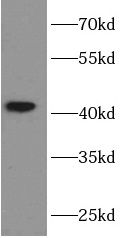Products
6*His, His-Tag antibody
| Size | Price |
|---|---|
| 100µg | Inquiry |
- SPECIFICATIONS
- CITATIONS
- FIGURES
- CONDITIONS
- FAQS
- Product Name
- 6*His, His-Tag antibody
- Catalogue No.
- FNab00008
- Size
- 100μg
- Form
- liquid
- Purification
- Protein A+G purification
- Purity
- ≥95% as determined by SDS-PAGE
- Clonality
- monoclonal
- Isotype
- IgG1
- Clone ID
- 1C4
- Storage
- PBS with 0.02% sodium azide and 50% glycerol pH 7.3, -20℃ for 12 months(Avoid repeated freeze / thaw cycles.)
- Alternative Names
- 6*His|6*His|His Tag|6histag|6XHis|HHHHHH|HIS|His Tag|HISTIDINE TAGGED antibody
- Tested Applications
- ELISA, WB, IP, IF
- Recommended dilution
- WB: 1:1000-1:10000; IP: 1:1000-1:10000; IF: 1:20-1:100
 Western blot of 6*His-tagged fusion protein with FNab00008(anti-6*HIS tag) at dilution of 1:5000.
Western blot of 6*His-tagged fusion protein with FNab00008(anti-6*HIS tag) at dilution of 1:5000.
 IP Result of anti-6*His, His-Tag (IP: FNab00008, 7ug; Detection: FNab00008 1:500) with Transfected HEK-293 cells lysate 300ug
IP Result of anti-6*His, His-Tag (IP: FNab00008, 7ug; Detection: FNab00008 1:500) with Transfected HEK-293 cells lysate 300ug
 Immunofluorescent analysis of Transfected HEK-293 cells using FNab00008 ( 6*His, His-Tag Antibody) at dilution of 1:25 and Alexa Fluor 488-conjugated Goat Anti-Mouse IgG(H+L)
Immunofluorescent analysis of Transfected HEK-293 cells using FNab00008 ( 6*His, His-Tag Antibody) at dilution of 1:25 and Alexa Fluor 488-conjugated Goat Anti-Mouse IgG(H+L)
- Background
- Protein tags are protein or peptide sequences located either on the C-or N-terminal of the target protein, which facilitates one or several of the following characteristics: solubility, detection, purification, localization and expression. His tag is often used for affinity purification and binding assays. Expressed His-tagged proteins can be purified and detected easily because the string of histidine residues binds to several types of immobilized metal ions, including nickel, cobalt and copper, under specific buffer conditions. The His tag antibody is a useful tool for monitoring of the His-tagged proteins, and recognizes His-tags placed at N-terminal, C-terminal, and internal regions of fusion proteins expressed in bacteria, insect, and mammalian cells.
- Journal:
- The Plant Cell
- Cited Date:
- 2022-07-08
- Product:
- Journal:
- Protein Science
- Author:
- Biochemistry and Molecular Biology Department, Biosciences Faculty, Universitat Autònoma de Barcelona, Barcelona, Spain.
- Sample:
- HEK293T cells
- Cited Date:
- 2024-06-28
- Product:
- Journal:
- bioRxiv
- Author:
- Buck Institute for Research on Aging, Novato, CA USA
- Cited Date:
- 2023-07-07
- Product:
How many times can antibodies be recycled?
First, usually it's not suggested to recycle antibodies. After use, buffer system of antibodies has changed. The storage condition of recycled antibodies for different customers also varies. Thus, the performance efficiency of recycled antibodies can’t be guaranteed. Besides, FineTest ever conducted the antibody recycling assay. Assay results show recycling times of different antibodies also varies. Usually, higher antibody titer allows more repeated use. Customers can determine based on experimental requirements.
Notes: After incubation, we recycle rest antibodies to centrifuge tube and store at 4℃. High titer antibodies can be stored for a minimum of one week. Reuse about three times.
What are components of FineTest antibody buffer?
Components of FineTest antibody buffer are usually PBS with proclin300 or sodium azide, BSA, 50% glycerol. Common preservative is proclin300 or sodium azide, which is widely applied in the lab and industry.
How about the storage temperature and duration of FineTest antibodies?
Most antibodies are stored at -20℃. Directly-labeled flow cytometry antibodies should be stored at 2 - 8℃. The shelf life is one year. If after sales issues for purchased antibodies appear, return or replacement is available. Usually, antibodies can be still used after the one-year warranty. We can offer technical support services.
Is dilution required for FineTest antibodies? What’s the dilute solution?
Directly-labeled flow cytometry antibodies are ready-to-use without dilution. Other antibodies are usually concentrated. Follow the dilution ratio suggested in the manual. Dilute solution for different experiments also varies. Common antibody dilution buffers are acceptable(e.g. PBST, TBST, antibody blocking buffer).
How to retrieve antibodies for immunohistochemistry?
Common retrieval buffers: Tris-EDTA Buffer(pH 9.0); Citrate Buffer(pH 6.0)
Heat induced antibody retrieval:
Method 1: Water-bath heating: Put the beaker with retrieval buffer and slide in the boiling water bath. Keep the boiling state for 15min. Naturally cool to room temperature;
Method 2: Microwave retrieval: Put the beaker with retrieval buffer and slide in the microwave oven. Heat at high power for 5min, Switch OFF for 3min, Heat at medium power for 5min. Naturally cool to room temperature.
How to choose secondary antibodies?
(1) Secondary antibodies react with primary antibodies. Thus, secondary antibodies should be against host species of primary antibodies. E.g. If the primary antibody is derived from rabbit, the relevant secondary antibody should be against rabbit. E.g. goat anti rabbit or donkey anti rabbit.
(2) Choose secondary antibody conjugates according to the experimental type, e.g. ELISA, WB, IHC etc. Common enzyme conjugated secondary antibodies are labelled by HRP, AP etc. Fluorescin or dye labelled secondary antibodies are applied in immunofluorescence and flow cytometry(e.g. FITC, Cy3).
